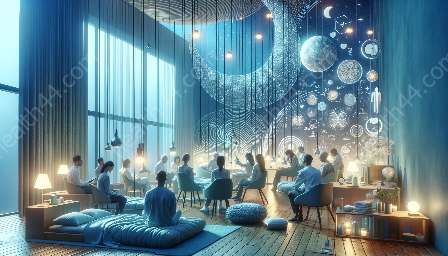Hypnagogic hallucinations are an intriguing phenomenon that occurs during the transitional state between wakefulness and sleep. These hallucinations can manifest in various forms, from sensory experiences to vivid visual imagery, and they often have a significant impact on individuals' sleep patterns and overall well-being. In this comprehensive guide, we will explore the nature of hypnagogic hallucinations, their relationship to sleep disorders, and their potential connection to various health conditions.
What Are Hypnagogic Hallucinations?
Hypnagogic hallucinations occur during the hypnagogic state, which is the transitional period between wakefulness and sleep. This stage is characterized by a state of relaxation, decreased awareness of the external environment, and an increase in internal mental processes. During this period, individuals may experience a range of sensory and perceptual disturbances, including auditory, visual, and tactile hallucinations.
Types of Hypnagogic Hallucinations:
- Visual Hallucinations: Individuals may see vivid and often colorful images, shapes, or even entire scenes that are not based in reality. These visual hallucinations can range from mundane objects to fantastical creatures and landscapes.
- Auditory Hallucinations: Some individuals may perceive sounds, voices, music, or other auditory stimuli that are not present in their external environment. These auditory hallucinations can be experienced as clear and distinct voices or as muffled, indistinct noises.
- Tactile Hallucinations: In some cases, individuals may feel physical sensations, such as the sense of being touched, pressure on the body, or movement, despite no external stimuli being present.
- Other Sensory Hallucinations: Smell and taste sensations can also be experienced during hypnagogic hallucinations, although these are less commonly reported.
Hypnagogic Hallucinations and Sleep Disorders
The occurrence of hypnagogic hallucinations is often associated with various sleep disorders, such as narcolepsy, sleep paralysis, and REM sleep behavior disorder (RBD). These conditions can disrupt the normal sleep-wake cycle and lead to abnormal transitions between wakefulness and sleep, increasing the likelihood of experiencing hypnagogic hallucinations.
Narcolepsy: This neurological disorder is characterized by excessive daytime sleepiness, sudden loss of muscle tone (cataplexy), sleep paralysis, and hallucinations, including hypnagogic and hypnopompic hallucinations, which occur during the transition into and out of sleep.
Sleep Paralysis: This phenomenon involves the temporary inability to move or speak while falling asleep or waking up. During episodes of sleep paralysis, individuals may experience hypnagogic hallucinations alongside a feeling of pressure on the chest, as if something or someone is sitting on them.
REM Sleep Behavior Disorder (RBD): In RBD, individuals act out their dreams during REM sleep, often with vocalization or complex motor behaviors. This disorder can be accompanied by vivid and intense hypnagogic hallucinations that can affect the individual's perception of reality.
Health Conditions and Hypnagogic Hallucinations
While hypnagogic hallucinations are commonly associated with sleep disorders, they may also have connections to various health conditions and psychiatric disorders. Some individuals may experience hypnagogic hallucinations as a symptom of underlying medical or psychological conditions, including:
- Mood Disorders: Conditions such as bipolar disorder and major depressive disorder may be linked to an increased prevalence of hypnagogic hallucinations, potentially due to disturbances in sleep patterns and the regulation of neurotransmitters.
- Neurological Disorders: Certain neurological conditions, such as migraine with aura, epilepsy, and Parkinson's disease, have been associated with an elevated risk of experiencing hypnagogic hallucinations, possibly due to disruptions in brain function and sensory processing.
- Substance Use and Withdrawal: The use of certain substances, such as alcohol, cannabis, and hallucinogens, can influence the occurrence of hypnagogic hallucinations, particularly during periods of intoxication or withdrawal.
- Post-Traumatic Stress Disorder (PTSD): Individuals with PTSD may experience hypnagogic hallucinations as part of their overall symptom profile, potentially related to the impact of trauma on sleep and the regulation of stress hormones.
Managing Hypnagogic Hallucinations
For individuals experiencing disruptive hypnagogic hallucinations, effective management strategies can help mitigate their impact on overall sleep quality and well-being. Some approaches to managing hypnagogic hallucinations may include:
- Sleep Hygiene: Establishing a consistent sleep routine, creating a comfortable sleep environment, and practicing relaxation techniques can contribute to more stable transitions between wakefulness and sleep, potentially reducing the occurrence of hypnagogic hallucinations.
- Medical Intervention: In cases where hypnagogic hallucinations are associated with underlying sleep disorders or health conditions, seeking medical evaluation and treatment from qualified healthcare professionals may be beneficial. This can involve comprehensive sleep assessments, diagnostic testing, and targeted interventions to address specific contributing factors.
- Cognitive-Behavioral Therapy (CBT): CBT techniques, including cognitive restructuring and relaxation training, can help individuals manage the distress associated with hypnagogic hallucinations and develop adaptive coping strategies to minimize their impact on sleep and overall well-being.
- Psychopharmacological Approaches: In some situations, targeted pharmacological interventions, such as medications for sleep disorders or psychiatric conditions, may be considered to address the underlying factors contributing to hypnagogic hallucinations.
- Supportive Lifestyle Modifications: Engaging in regular physical activity, maintaining healthy dietary habits, and reducing stress through mindfulness practices can contribute to overall well-being and potentially positively influence sleep patterns and hypnagogic hallucinations.
Conclusion
Hypnagogic hallucinations represent a fascinating and complex aspect of the sleep experience, intertwining with sleep disorders and various health conditions. By understanding the nature of hypnagogic hallucinations and their potential connections to sleep and health, individuals can work toward effective management strategies that promote improved sleep quality and overall well-being. Exploring these relationships can also enhance awareness of the intricate interplay between the mind, body, and sleep, paving the way for more holistic approaches to sleep health and the management of related conditions.


